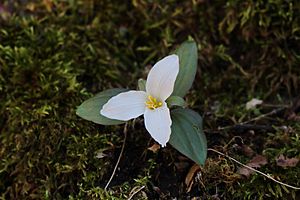Snow trillium facts for kids
Quick facts for kids Snow trillium |
|
|---|---|
 |
|
| T. nivale in bloom in Paint Township, Ohio | |
| Conservation status | |
| Scientific classification | |
| Genus: |
Trillium
|
| Species: |
nivale
|
The Snow Trillium, also known as Trillium nivale or dwarf white trillium, is a small, beautiful flowering plant. It belongs to the Melanthiaceae family. This plant grows naturally in parts of the eastern and midwestern United States. You can find it mainly in the Great Lakes States, the Ohio Valley, and the Upper Mississippi Valley, reaching as far north as central Minnesota.
Contents
What is the Snow Trillium?
The Snow Trillium is a perennial herbaceous plant. This means it's a plant that lives for more than two years and does not have a woody stem above ground. It's special because it flowers very early in the year, sometimes even when there's still snow on the ground! In warmer areas like the Ohio River valley, you might see its white flowers in early March. Further north in Minnesota, it blooms in early April.
Along with the eastern skunk cabbage, the Snow Trillium is one of the first spring ephemerals to appear. A "spring ephemeral" is a plant that grows, flowers, and sets seeds very quickly in the spring, then disappears by summer. Even though it can handle cold winters, the Snow Trillium doesn't grow much farther north than its current range.
Life Cycle of the Snow Trillium
The Snow Trillium has an interesting life cycle that takes many years. Like other plants in the Trillium group, it starts with a single leaf. This is called the one-leaf vegetative stage. After this, it grows into a three-leaf vegetative stage, which is like its teenage years.
It takes a long time, often twelve years or more, for the plant to grow enough to finally reach its three-leaf reproductive stage. This is when it can produce flowers and seeds. In some places, you might see ten or more young, one-leaf plants for every one that is flowering. Once a Snow Trillium starts to flower, it can live for many more years, sometimes even decades!
How Does it Reproduce?
After the Snow Trillium's flower is pollinated (which means pollen is moved from one flower to another, often by insects), its flower stalk, called a pedicel, starts to bend downwards. By the time the fruit is ready, it hangs below the leaves. In June, the plant releases its seeds. Soon after, the part of the plant above the ground disappears until the next spring.
The seeds of the Snow Trillium are spread by ants. Ants carry the seeds away, which helps the plant spread to new places. This way of spreading seeds might be why some groups of Snow Trillium plants don't have much genetic variety.
Where Does it Grow?
The Snow Trillium is smaller than many other Trillium species. It usually grows to be no more than 9 cm (3.5 in) (about 3.5 inches) tall. Unlike most trilliums, which prefer rich, leafy soil, the Snow Trillium likes different kinds of ground. It prefers sandy gravel that contains lime, cracks in limestone rocks, or mineral soil that is rich in calcium. This unique preference for soil helps it grow in specific areas.
Images for kids



